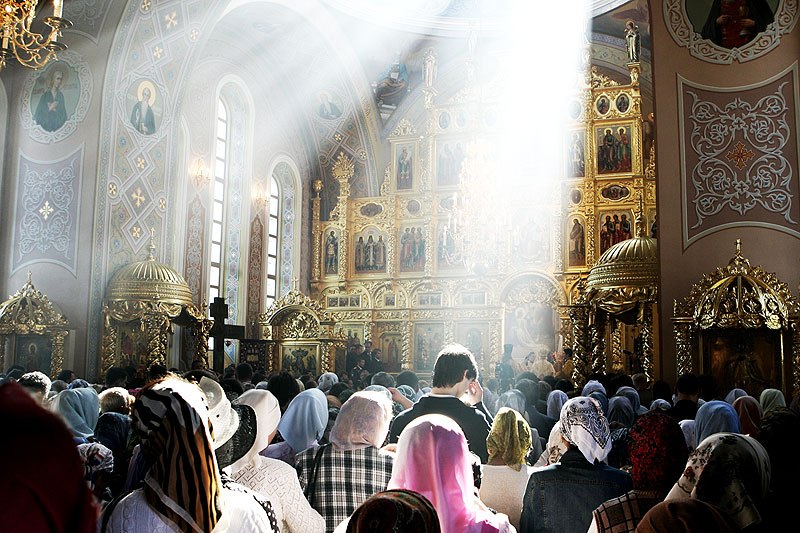|
The House of God: An Explanation of the Interior of Orthodox Churches The visitor to an Orthodox Church is usually impressed by the unique features and the external differences between this place of worship and those of the various traditions of Western Christianity. The rich color, distinctive iconography and beauty of the interior of an Orthodox Church generally are in sharp contrast to the simplicity which one finds in many Roman Catholic and Protestant churches. When one enters the interior of the Orthodox church it is like stepping into a whole new world of color and light. The art and design of the church not only create a distinctive atmosphere of worship, but also they reflect and embody many of the fundamental insights of Orthodoxy. Beauty and Symbols The Orthodox Church believes that God is the Creator of heaven and earth. The Creator is present through His creative energies of His handiwork. This means that the material world, being valuable and good, is an important means through which God expresses Himself. Orthodox Christianity affirms this conviction through her extensive use of material creation not only for the embellishment of her places of worship, but also in her sacramental mysteries and services. For example, when the bread and wine - "the first fruits of creation" - are offered in the Eucharist, they are also a symbolic offering of all creation to God its Creator. Since there is no hesitation in using the gifts of creation, the interior of an Orthodox church is frequently very beautiful. Designed to create an atmosphere which is special, the building is filled with a feeling of joy and an appreciation of God’s bounty. Orthodox Christiany recognizes that beauty is an important dimension of human life. Through iconography and church appointments, the beauty of creation becomes a very important means of praising God. The divine gifts of the material world are shaped and fashioned by human hands into an expression of beauty which glorifies the Creator. As the pious woman poured her most precious oil on the feet of Our Lord, Orthodoxy seeks always to offer to God what is best and most beautiful. Sacred Space The interior of the church is, most importantly, both the background and the setting for Orthodox worship. The art and architecture are designed to contribute to the total experience of worship, which involves intellect, feelings, and senses. The Eucharist and the other Sacramental Mysteries take place in God’s midst, and they bear witness to His presence and actions. There is a very strong sense in the Orthodox tradition that the church is the House of God and the place where His glory dwells. For this reason, all Orthodox churches are blessed, consecrated, and set aside as “sacred space.” The whole church building bears witness to God’s indwelling among His people. As one old admonition says: Ideally, an Orthodox church is relatively small and intimate to emphasize and enhance the sense of community in worship. The church is generally constructed in the form of a cross and is divided into three areas: the narthex, the sanctuary (or nave), and the altar (or holy of holies). The Narthex The narthex is the entrance area to the church, or vestibule. In earlier times catechumens (learners) and penitents remained in the narthex during parts of the services. The beginning of the Baptismal service, and the Marriage Service in some parishes, begin in the narthex and proceed into the nave. This procession symbolically represents a gradual movement into the Kingdom of God. In many Orthodox parishes, the narthex is the area where the faithful make an offering, receive a candle, light it before an icon, and offer a personal prayer before joining the congregation. The Sanctuary or Nave The sanctuary is the large center area of the church. Here the faithful gather for worship. The Orthodox tradition is to have an open nave with no pews, but seats at the back and sides. In America some churches may have pews. On the right and left sides of the nave are places for the readers, chanters, and choirs. According to tradition, the Gospel is proclaimed, and the sermon is preached, from the center of the church. In some churches there may be a pulpit on the left side from which the the sermon may be preached. The Altar or Holy of Holies The altar area, or holy of holies, is the most-sacred area of the church. It contains the Holy Table (Altar) and is separated from the nave by an “Iconostasion.” This division serves to remind us that God’s reign is not yet perfected and that we often find ourselves “separated” from Him through sin. During the Divine Liturgy, however, we have access to the Holy Gifts and are reminded that heaven and earth are united through Christ and that in Him we have access to the Father. The Altar or Holy Table is the heart and focal point of the Orthodox Church. It is here that eucharistic gifts of bread and wine are offered to the Father as Christ commanded us to do. The Altar, which is usually square in shape, stands away from the wall and is often covered with cloths. A tabernacle, with reserved Holy Communion for the sick or dying, is set upon the Altar, together with candles. When the Divine Liturgy is not being celebrated, the Book of Gospels rests on the Altar. The Iconostasion The Iconostasion is a panel, or wall, with icons which separates the altar area from the sanctuary. The origin of this very distinctive part of an Orthodox church is the ancient custom of placing icons on a low wall before the altar. In time, the icons became fixed on a standing wall, hence the term iconostasion. In contemporary practice, the Iconostasion may be very elaborate and conceal most of the sanctuary, or it may be very simple and open. The Iconostasion has three entrances which are used during services. There is a door on either side, and the center entrance which is called the Beautiful Gate. A curtain and a low door close the Altar when services are not being celebrated. On On the right-hand side of the Iconostasion are icons of Christ and Saint John the Baptist. On the left-hand side are the icons of the Theotokos (Mother of our Lord) and the patron saint or event to which the church is dedicated. In addition to these icons, others may be added, depending upon custom and space. Icons An “icon” is an “image,” specifically a holy image. It is perhaps the distinctive art form of the Orthodox Church. An icon may be a painting on wood or canvas, and it may be a mosaic or fresco. Icons depict Christ, Mary the Theotokos, the saints, and angels. Icons may also portray events from the Scriptures or the history of the Church, such as Christmas, Pascha (Easter), etc. Icons have a prominent place in Orthodox worship and theology. The icon is not simply decorative, inspirational, or educational. Rather, it signifies the reality and presence of the individual or event depicted. The icon is like a window which links heaven and earth. We worship as part of the Church which includes the living and the departed, and we never lose contact with those who are with the Lord in glory. This belief is expressed every time one venerates an icon or places a candle before it. Many Orthodox churches have icons not only on the iconostasion but also on the walls, ceilings, and in arches. In the apse behind and above the altar area, there is very frequently a large icon of the Theotokos and the Christ Child. The Orthodox Church believes that Mary is the human being closest to God. This very prominent icon recalls her important role in the Incarnation of the Son of God. The icon is also an image of the Church. It reminds us of our responsibility to give birth to Christ’s presence in our lives. In the ceiling or dome, is the icon of “Christ the Almighty” (Pantocrator). This icon portrays the Triumphant Christ who reigns as Lord of heaven and earth. As one gazes downward, it appears as though the whole church and all of creation comes from Him. As one looks upward, there is the feeling that all things direct us to Christ the Lord. He is the “Alpha and the Omega,” the beginning and the end: this is the message of Orthodox Christianity.
|


